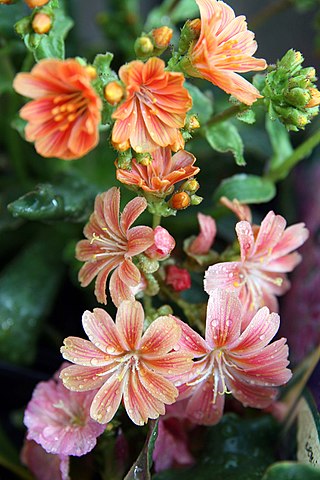
Lewisia is a plant genus, named for the American explorer Meriwether Lewis (1774-1809) who encountered the species in 1806. The native habitat of Lewisia species is rocky ground and cliffs in western North America. Local Native Americans ate the roots, which have also been used to treat sore throats.

Hastingsia serpentinicola is a species of flowering plant known by the common name Klamath rushlily. It is native to the mountains of northwestern California and southwestern Oregon, where it grows in serpentine soils.

Calochortus greenei is a species of flowering plant in the lily family known by the common name Greene's mariposa lily. It is native to northern California and southern Oregon, where it grows in the forest and woodlands of the mountains. It is a perennial herb which produces a branching stem up to about 30 centimeters in maximum height. There is a basal leaf about 20 centimeters long which does not wither at flowering. The inflorescence bears 1 to 5 erect bell-shaped flowers. Each flower has three sepals and three light purple petals with darker areas at the bases. The petals are 3 to 4 centimeters long and have a coat of long hairs on their inner surfaces. The fruit is a winged capsule about 2 centimeters long.

Calochortus nudus is a North American species of flowering plant in the lily family known by the common name naked mariposa lily.

Boechera breweri is a species of flowering plant in the family Brassicaceae known by the common name Brewer's rockcress.

Lewisia brachycalyx is a species of flowering plant in the family Montiaceae, known by the common name short-sepal bitter-root or shortsepal lewisia. It is native to the mountains of the southwestern United States and Baja California, where it grows in moist habitat such as meadows.
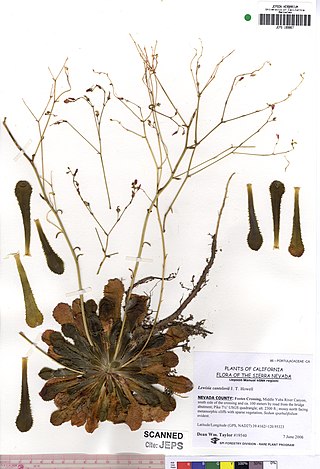
Lewisia cantelovii is an uncommon species of flowering plant in the family Montiaceae known by the common name Cantelow's lewisia. It is endemic to California, where it is known from the northeastern mountain ranges from the Klamath Mountains to the northern Sierra Nevada. It grows in rocky, moist mountain habitat. This is a perennial herb growing from a short, thick taproot and caudex unit. It produces a basal rosette of thick, fleshy, blunt-tipped spoon-shaped leaves with serrated edges. The inflorescence is a very slender erect stem up to 45 centimeters tall topped with a spreading panicle of flowers and glandular, toothed bracts. Each flower has 5 to 7 oval petals each one half to one centimeter long. The petals are white or very pale pink with sharp dark pink veins. At the center of the flower are five stamens tipped with dark pink anthers.
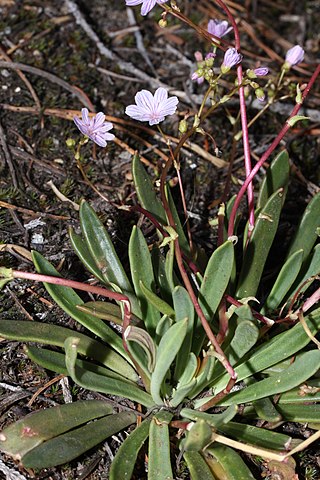
Lewisia columbiana, the Columbian lewisia, is a species of flowering plant in the family Montiaceae. It is native to the western United States and British Columbia, where it grows in rocky mountain habitats.

Lewisia congdonii, known by the common name Congdon's lewisia, is a rare species of flowering plant in the family Montiaceae.

Lewisia cotyledon is a species of flowering plant in the family Montiaceae known by the common names Siskiyou lewisia and cliff maids. It is native to southern Oregon and northern California, where it grows in rocky subalpine mountain habitat.

Lewisia disepala is a species of flowering plant in the family Montiaceae known by the common name Yosemite lewisia.

Lewisia kelloggii is a species of flowering plant in the family Montiaceae known by the common name Kellogg's lewisia. It is endemic to the Sierra Nevada of California, where it is known from several sites high in the mountains. It grows in rocky mountain habitat in granite and slate substrates. This is a perennial herb growing from a thick, short taproot and caudex unit. It produces a basal rosette of many thick, leathery, spoon-shaped leaves up to 9 centimeters long. The inflorescence bears several flowers, each on a very short stalk. The flower has 5 to 13 shiny white or pinkish petals just over a centimeter long. Under the petals are two sepals and two similar bracts lined with spherical resin glands.
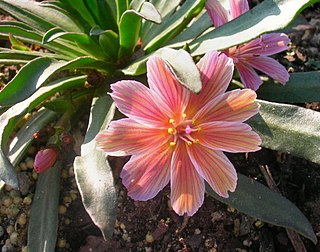
Lewisia longipetala is a rare species of flowering plant in the family Montiaceae known by the common names long-petalled lewisia and Truckee lewisia. It is endemic to the Sierra Nevada of California, where it is known from less than 20 locations in areas not far from Lake Tahoe. It grows in subalpine and alpine climates in moist areas in rocky habitat, such as talus that retains patches of snow year-round. Most specimens grow on north-facing slopes with little surrounding vegetation. The plant thrives in the snow, growing largest and most densely in areas of high snowpack and becoming easily water-stressed when far away from areas with snow.
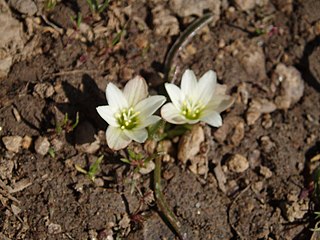
Lewisia nevadensis is a species of flowering plant in the family Montiaceae known by the common name Nevada lewisia. It is native to much of the western United States, where it grows in moist mountain habitat, such as meadows. This is a small perennial herb growing from a taproot and caudex unit. It produces a basal rosette of several narrow, fingerlike to threadlike fleshy leaves up to 13 centimeters long. The inflorescence is a bundle of short stems a few centimeters tall each bearing a flower. The flower has 5 to 10 shiny white to pale pink petals each 1 to 2 centimeters long, pointed or with blunt tips. At the center are many stamens. This is sometimes grown as an ornamental plant suitable for alpine and rock gardens.

Lewisia oppositifolia is a rare species of flowering plant in the family Montiaceae known by the common name opposite-leaf lewisia. It is native to the Klamath Mountains of Josephine County, Oregon, and Del Norte County, California, where it is a local serpentine endemic generally found in moist areas. This is a perennial herb growing from a small taproot and caudex unit. It produces a basal rosette of several lance-shaped, blunt-tipped fleshy leaves up to 11 centimeters long. There are sometimes smaller leaves located on the lower stem. The inflorescence is made up of one or more erect stems up to about 20 centimeters long, each bearing 1 to 6 flowers. The flower has 8 to 11 white to pale pink petals with blunt or jagged tips, each between 1 and 2 centimeters long. At the center are several stamens with pale anthers. This plant has a limited distribution and it is threatened by human activity in the area, such as logging.

Lewisia pygmaea is a species of flowering plant in the family Montiaceae known by the common name alpine lewisia and pygmy bitterroot. It is native to western North America from Alaska and Alberta to California and New Mexico, where it grows in many types of moist, rocky mountain habitat, such as gravel beds and sandy meadows.

Lewisia stebbinsii is a rare species of flowering plant in the family Montiaceae known by the common name Stebbins' lewisia. It is endemic to California, where it is known from less than fifteen sites in the Inner North Coast Ranges of Mendocino and Trinity Counties, mainly in Mendocino National Forest.
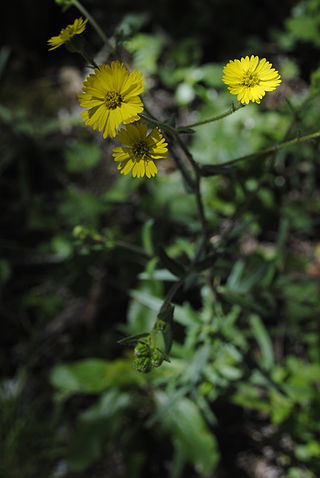
Anisocarpus madioides is a North American species of flowering plant in the family Asteraceae known by the common name woodland madia.

Raillardella argentea is a species of flowering plant in the family Asteraceae known by the common name silky raillardella. It is native to the Sierra Nevada and nearby mountain ranges of California, its distribution extending east into Nevada and north along the Cascade Range and Klamath Mountains into Oregon. It grows in many types of dry, open mountain habitat. It is a rhizomatous perennial herb growing in a clump of rosetted basal leaves. The leaves are lance-shaped, up to 8 centimeters long, and coated in silky hairs. The plant produces an inflorescence up to about 15 centimeters tall consisting of a solitary flower head which is cylindrical to somewhat bell-shaped. The head is enclosed in the fused outer scales of the flowers, which look similar to the phyllaries of many other species' flower heads. The head contains many yellow disc florets up to a centimeter long each, and no ray florets. The fruit is a long, narrow achene which may be 2 centimeters in length including its plumelike pappus.
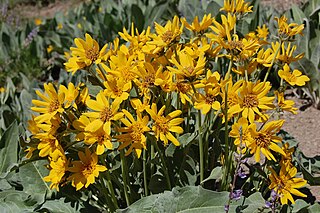
Wyethia mollis is a species of flowering plant in the family Asteraceae known by the common name woolly mule's ears. The plant is hairy to woolly in texture, sometimes losing its hairs with age.




















